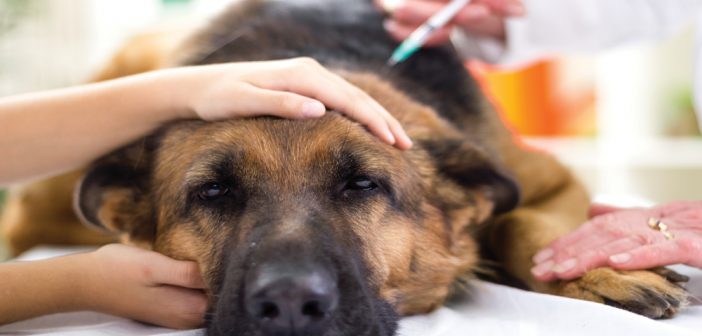Lymphoma is a cancer that is common in humans, but it also occurs in dogs too. While a diagnosis can be devastating for people and their pets, you can do your part by understanding the disease and participating in making decisions with your animal’s best interests in mind. Lymphoma in dogs occurs in several types, which in turn influences treatment options and prognosis.
Breeds Most Affected
According to the National Canine Cancer Foundation (NCCF), malignant lymphoma is one of the most common types of cancer in dogs. It typically arises in dogs that are middle aged or older (with a median age of 6-9 years). Breeds that see the highest rates of lymphoma diagnosis are Bull Mastiffs, Bassett Hounds, Scottish Terriers, Saint Bernards, Airedales, and bulldogs. Pomeranians and Dachsunds have the lowest risk of developing canine lymphoma. Once diagnosed, the NCCF reports that neutered female dogs of all species have the best chance of recovery and survival.
Similarities to non-Hodgkin’s Lymphoma
Before starting treatment for lymphoma, it is important to know about this type of cancer. Canine lymphoma resembles non-Hodgkin’s lymphoma in humans. It is a form of cancer that derives from the lymphocytes, which are white blood cells that work with the immune system to fend off infection.
Common Types of Canine Lymphoma
The most common types of canine lymphoma are: multicentric lymphoma, mediastinal lymphoma, alimentary lymphoma, and extranodal lymphoma. Some dogs will show no symptoms, while others become quite sick as cancer progresses. Depending on the area affected, your dog may have swollen lymph nodes, difficulty breathing, scaly lesions, and digestive problems.
Common Procedures and Tests
If your veterinarian thinks it might be cancer, he or she will take a biopsy of the affected organ. Veterinarians commonly perform this procedure with a fine-needle aspiration, which is a piece of diagnostic equipment that removes tissue to be evaluated through a cytology exam or a tissue evaluation. If the tests come back positive for canine lymphoma, your veterinarian might recommend staging tests. These tests will show the veterinarian how far the cancer has spread through your dog’s body, which in turn can affect the course of prescribed treatment. Staging tests might include a urinalysis, X-rays, blood tests, sonograms of the abdominal area, and aspiration of bone marrow.
Chemotherapy
Once the veterinarian has determined what type of canine lymphoma your dog has and how far it’s spread through the body, it is time to start treatment. Chemotherapy is one of the most common and most effective methods of treatment. Your veterinarian will choose chemotherapy based on the type of lymphoma that your pet has. In addition to chemotherapy, your veterinarian may recommend surgery to remove tumors or radiation therapy. If your dog has multicentric lymphoma, your dog may be prescribed a type of chemotherapy called UW-25. This chemotherapy is based on the same protocol that physicians use when treating human cancers. For cutaneous lymphoma, your veterinarian might instead recommend lomustine.
Side Effects from Chemotherapy
Dogs may suffer some side effects from chemotherapy. The good news for pets is that they do not usually get as sick as people after starting treatment, with the exception of poodles, Old English sheepdogs, and Bichon Frises. However, intestinal distress, a suppressed appetite, and lethargy are common symptoms.
Explore Options
It’s ok to shop around for cancer care; you might prefer one specialist to handle your dog’s care over another. Line up a few veterinary oncologists to talk to before choosing one. You can ask questions about prescribed courses of treatment and what additional tests you might do to get a better understanding of your dog’s illness. Veterinary oncologists are an excellent resource, they have access to the latest information and advanced treatment options.
Remission
After undergoing treatment with chemotherapy, the NCCF reports a complete remission rate in 60-90 percent of all cases. Dogs treated with chemotherapy have an average survival rate of six to 12 months. In about a quarter of all cases, dogs live for two years or more following the first round of treatment. With a second successful round of chemotherapy, dogs have a median survival time of about 11 months. Sometimes, oncologists will administer rescue protocols throughout the course of chemotherapy, which are supplementary drugs used to aid treatment if chemotherapy does not appear to be working. The survival rate for this emergency treatment is approximately one to two months. Treatments with multiple components (such as chemotherapy plus radiation or surgery) have the best outcomes, with average success rates of 88 to 96 percent, and a median survival period of about a year. Your dog’s chance of recovery depends on the type of lymphoma and the stage of the illness.
Possible Causes
Scientists have not yet determined what causes canine lymphoma, and therefore they have no standard recommendation for prevention. However, researchers have some clues about what might cause this cancer. Some environmental conditions, including toxins from herbicides, agricultural and crop chemicals, and magnetic fields, may be responsible for cancer development. Some household cleaners and exposure to second-hand smoke are thought to increase the chance of developing lymphoma. Since some breeds are affected more than others, scientists suspect that there may be a genetic component to lymphoma. They believe that some types of lymphoma occur as a result of a random genetic mutation or abnormal chromosome activity. However, researchers hope that continued work on genetic studies may shed light on potential genetic and chromosomal factors.
Whether you’re hoping to reduce the risk of your dog getting lymphoma or if you are exploring options for treatment, understanding the condition is one of the best things you can do as a loyal pet owner. Everyone hopes that treatment will work for their animal, but sadly that is not always the case. If your pet’s prognosis is poor, talk with your veterinarian about hospice care and see how you can keep your dog happy and comfortable.









